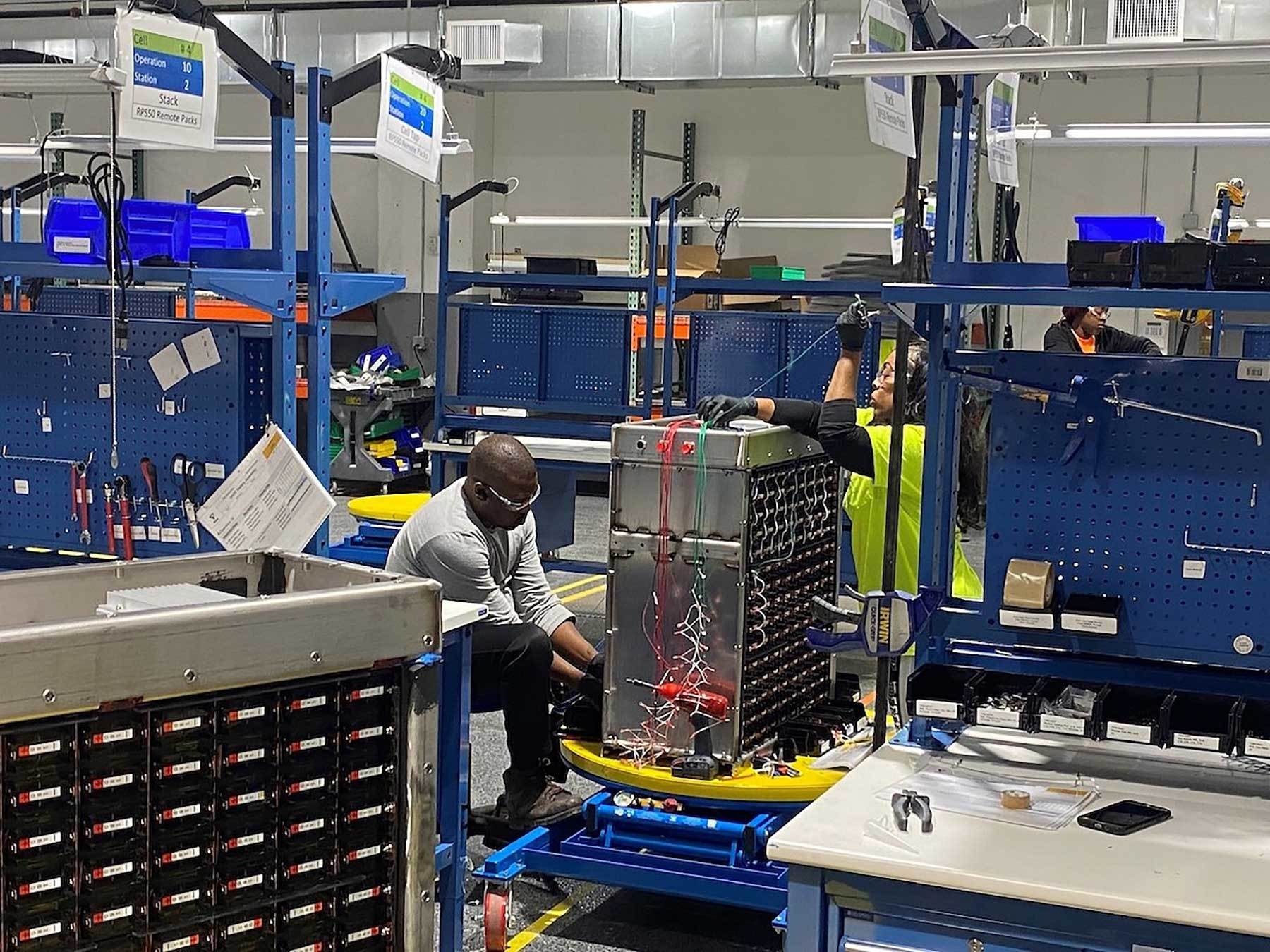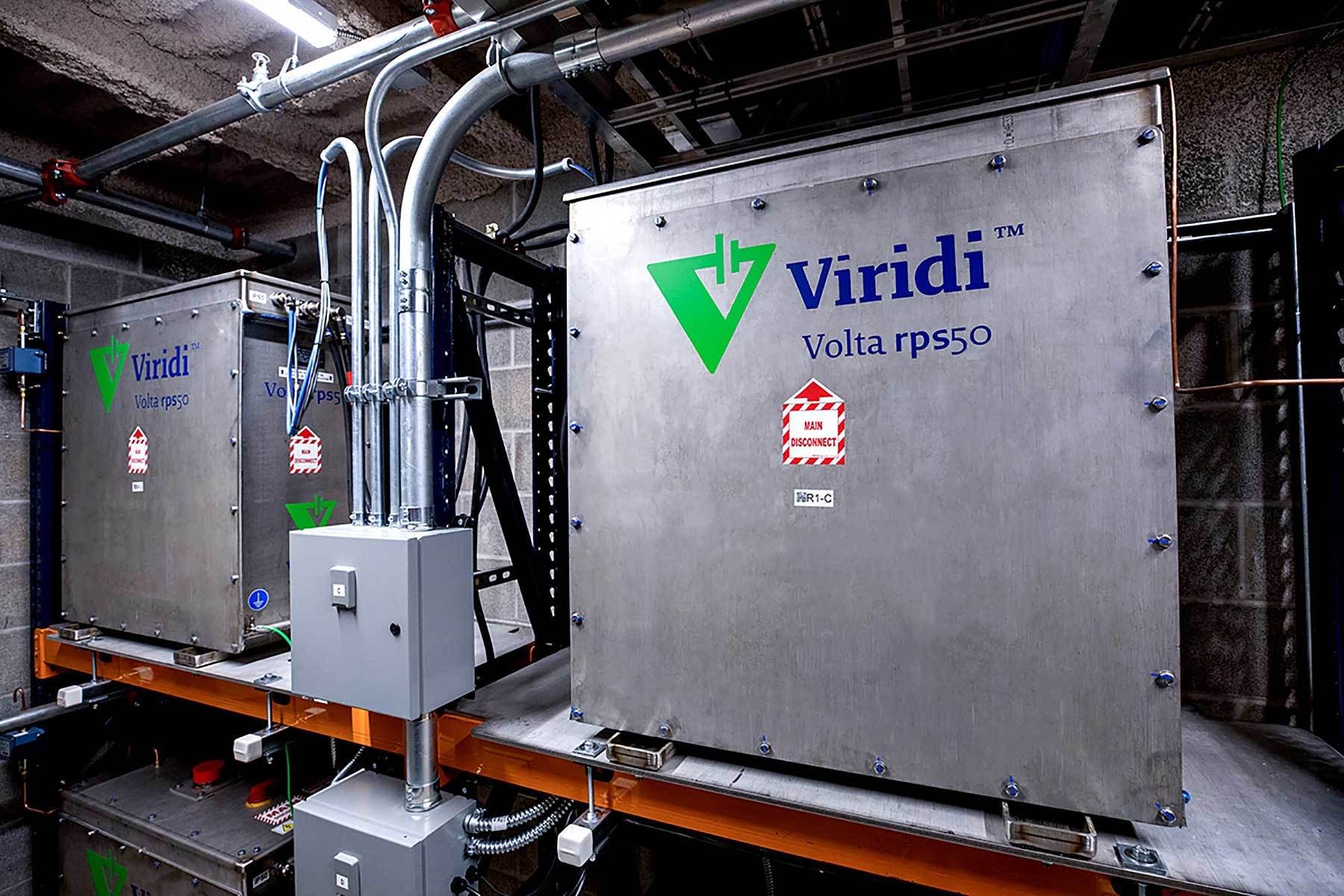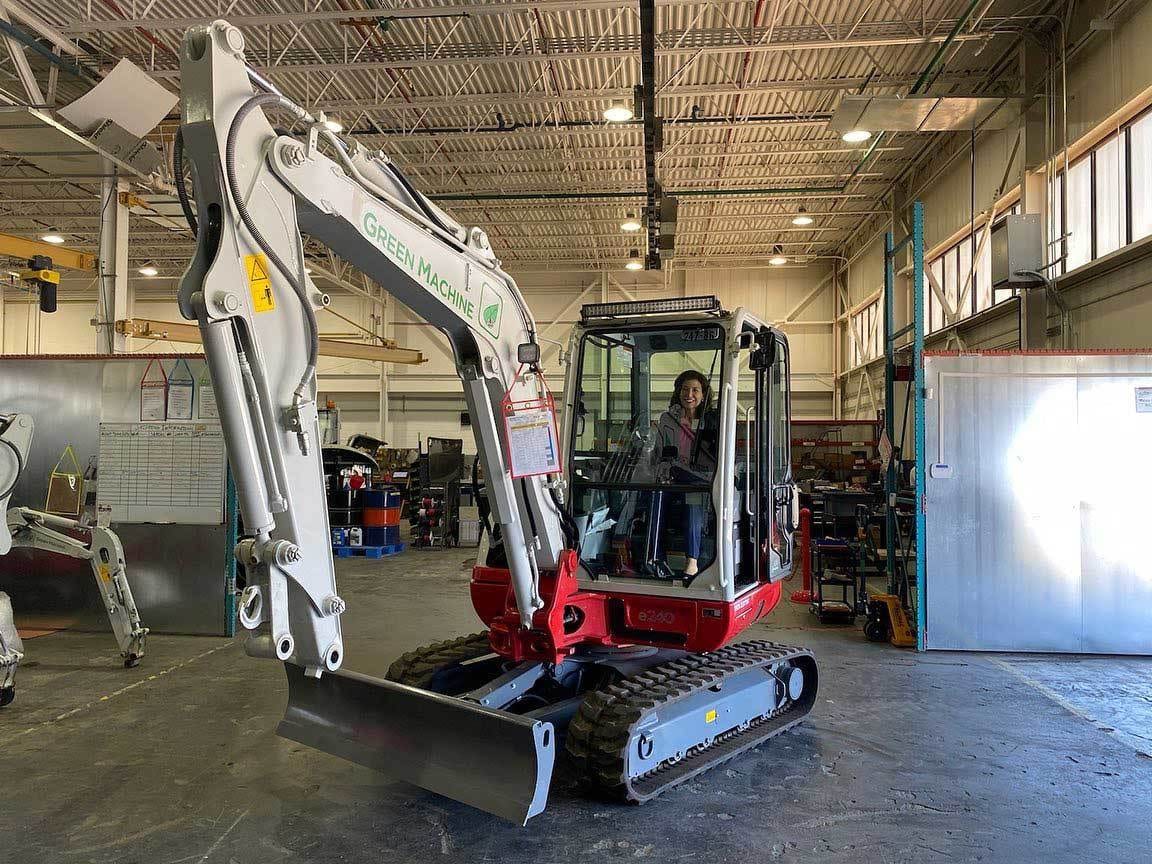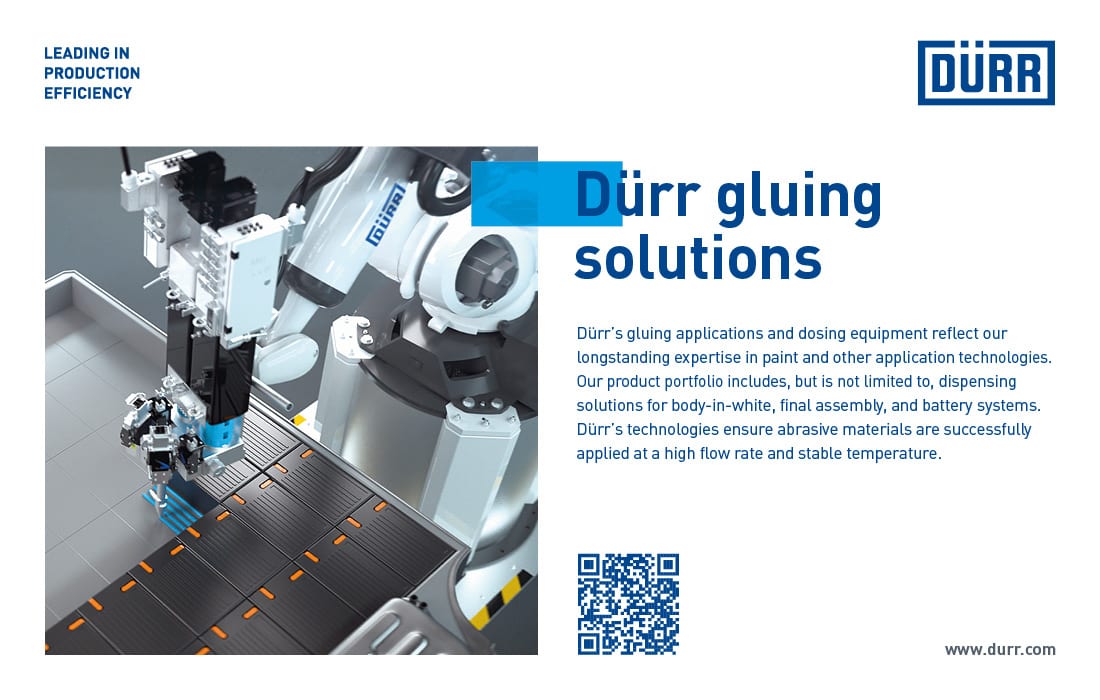APRIL 2023

ASSEMBLY AUTOMATION
Flexible Automation Boosts Battery Production
Standardized, software-driven assembly cells enable start-up to manufacture batteries domestically.
Labor shortages are driving new demand for automation.
Options for Screwfeeding
Viridi sponsors GreenForce, a community-based nonprofit organization that recruits unemployed and underemployed candidates and provides them with training and support to obtain advanced manufacturing jobs. Photo courtesy Viridi Parente Inc.
John Sprovieri // Chief Editor
Inside a former auto parts factory in Buffalo, NY, Jon M. Williams is making plans to create a renewable energy trailblazer.
His start-up company, Viridi Parente Inc., makes lithium-ion batteries—brand-named Green Machine—for construction equipment, such as excavators, enabling the machines to run on electricity instead of diesel fuel. The brand is being lauded for its long cycle life, resilient physical design and completely self-contained architecture. The batteries have already logged more than 250,000 hours of field use with actual customers. By some estimates, the market for electric-powered construction equipment could reach $205 billion in North America by 2025.
An alternative version of the battery—brand-named Volta Energy—provides a source of stored energy to power buildings. The batteries are designed to be fail-safe for installation in occupied spaces. Battery systems can be configured to provide from 50 kilowatt-hours to 5 megawatt-hours of distributed energy storage at the point-of-use. Applications include data centers, manufacturing facilities, homes, businesses and research facilities—anywhere that fail-safe, resilient, renewable energy is needed.
Now, Viridi is ramping up production. In January 2022, the company raised $95 million from investors to accelerate its growth plans. Viridi hopes to go from making a “couple thousand” batteries in 2022 to 10,000 to 20,000 units in 2023, says Williams, chairman and CEO of Viridi.
AUTOMATING WITH MICROFACTORIES
Specifically, Viridi will deploy a series of Microfactories from Bright Machines to automate production. Software-driven Microfactories designed to be flexible, modular and scalable. “Whereas traditional automation takes a hardware-first approach, we take a software-first approach,” says Stevan Dobrasevic, product marketing director. “We set up our modules with software, we configure them with software, we run them with software, and we analyze and optimize their performance with software.”
Since the company was founded in 2018, more than 100 microfactories have been deployed in 13 countries serving more than 40 manufacturers.
Microfactories are created by combining one or more Bright Robotic Cells (BRCs) to form an automated assembly line. Three cell sizes are available: the BRC35, BRC70 and BRC100. Each BRC has a standard configuration that includes the chassis, electrical cabinet, robot, power supply, and a 21-inch touch screen display. The cells can be used together in any combination on the same line to assemble products with heights up to 220 millimeters and weights up to 30 kilograms, including the pallet.
The BRC35 has an internal volume of 35 cubic feet and can accommodate a maximum pallet size of 700 by 450 millimeters. It’s equipped with a Nachi EZ06 four-axis SCARA robot with a maximum payload of 5 kilograms.
The BRC70 has an internal volume of 70 cubic feet and can accommodate a maximum pallet size of 700 by 600 millimeters. It’s equipped with a Fanuc LR Mate 200iD/7L six-axis robot with a maximum payload of 7 kilograms.
The BRC100 has an internal volume of 100 cubic feet and can accommodate a maximum pallet size of 1,200 by 600 millimeters. It’s equipped with dual gantries.
The cells are compatible with vibratory feeder bowls and other parts feeding equipment from outside suppliers. In addition, Bright Machines has developed two standardized tray feeders, the Tray Feeder 305 and the Tray Feeder 600, which fit into the back of the BRC70 or the BRC100. Each feeder can hold 25 trays, and trays can be swapped out in approximately 6 seconds. Each tray can hold up to 10 kilograms of parts. The 305 can accommodate a maximum part size of 280 by 380 by 200 millimeters, while the 600 can handle a maximum part size of 560 by 380 by 200 millimeters.
Each cell has an embedded conveyor to pass pallets from cell to cell. Return conveyors bring pallets back to the start of the line. Elevators transport pallets vertically between the embedded conveyor and return conveyor. Extension conveyors can be placed in the line where needed to accommodate manual workstations or automated stations that don’t require a cell.

Viridi hopes to go from making a “couple thousand” batteries in 2022 to 10,000 to 20,000 units in 2023. Photo courtesy Viridi Parente Inc.
Robot end-effectors are available for various assembly tasks, such as pick and place. Equipment is also available for:
- Installing threaded fasteners, clips and washers.
- Welding, soldering and heat staking.
- Dispensing adhesives, sealants, grease and thermal paste.
- Press-fit assembly, such as installing bearings, connectors or DIMM cards.
- Printing and applying labels.
- Laser engraving.
Machine vision can be integrated for tasks such as inspection, sorting, bar code scanning, optical character recognition and robot guidance. Test equipment can be integrated for power-up testing, display testing and RF validation

Viridi’s Volta batteries provide stored energy to power buildings. The batteries are designed to be fail-safe for installation in occupied spaces. Photo courtesy Viridi Parente Inc.
SOFTWARE-DRIVEN AUTOMATION
Intuitive user interfaces provide line operators and technicians with graphical controls to operate, monitor and make modifications to their Microfactories.
The company’s Brightware Platform and Brightware Studio software, enable line operators and line managers to run work orders, manage material flow, recover from errors, perform product changeovers, and track key production metrics. Automation engineers and service engineers can easily configure and program Microfactories using a streamlined workflow. Technicians can quickly adjust device settings, modify assembly instructions, set up new recovery routines, implement product traceability, and reuse hardware modules.
It’s also possible to collect component, product, process and equipment data at all assembly stages to reduce scrap cost and improve product quality.
Any automation component, whether it is designed by Bright Machines or comes from a third party, can be quickly added to a cell using an open-framework device wizard to set up a driver for it in the system’s control software, Brightware. And, when it comes time to wind down production, the components can be repurposed to build the next product.
“Software-driven automation means that all these hardware modules are pre-integrated into the software,” says Dobrasevic. “Everything is plug-and-play.
“Within the software, you can quickly create production ‘recipes’ for a specific product. For example, you can program a conveyor to position a pallet for installing screws. These recipes are configured using graphical means, so they don’t require a whole lot of programming.”
With the software-first approach, engineers can have a system up and running in three to six months, says Dobrasevic.

New York Gov. Kathy Hochul tries out a battery-powered excavator at Viridi’s assembly plant in Buffalo, NY. Photo courtesy Viridi Parente Inc.
AUTOMATION AND SUSTAINABILITY
For Williams, Viridi is more than a profit-making venture. He hopes the company will be an economic growth engine that helps revitalize Buffalo. To that end, Viridi is the sponsoring employer of GreenForce, a community-based nonprofit organization that recruits unemployed and underemployed candidates and provides them with training and support to obtain, and maintain, advanced manufacturing positions.
Williams also wants his company to follow sustainable production practices, and he believes automation will help. Localizing the production of critical battery components is the only way to drive down costs, emissions, and geopolitical risks while meeting U.S. demand for electrification, Williams argues. Automation will enable Viridi to manufacture batteries domestically rather than in low-cost labor countries overseas.
As a result, Viridi will be able to reduce overproduction and instead produce-to-order based on local market demand. Additionally, Bright Machines’ artificial intelligence software will continually assess Viridi’s production to identify the best ways to reduce defect rates and scrap. The result will be less landfill and an overall reduction in Viridi’s carbon footprint.
“Viridi is dedicated to creating the next generation of energy systems,” says Williams. “Sustainable production has never been more important for our customers or us; Bright Machines will make hitting our assembly and environmental goals possible at scale, while helping support our efforts to manufacture products responsibly.”
“We’re excited to collaborate with a disruptive energy company like Viridi, which is committed to driving efficient, sustainable production for their products,” adds Gayle Sheppard, co-CEO of Bright Machines. “Bright Machines is helping transform one of the world’s largest industries by enabling manufacturers like Viridi to localize operations, which is both economically and environmentally advantageous. Enabling the transformation of how and where people make products is core to our mission. We’re proud to partner with Viridi to help achieve its production goals in the U.S. and deliver on its promises to customers.”
For more information on software-driven assembly cells, click www.brightmachines.com.

ASSEMBLY ONLINE
For more information on assembly automation, visit www.assemblymag.com to read these articles:


